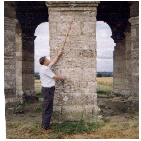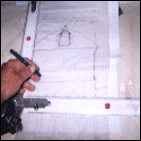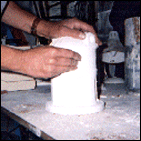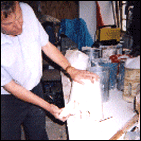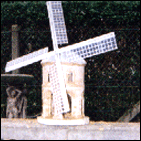
Architect Mr Gerald Kennard surveying the piers of the real Chesterton Windmill built in 1632
Detail measurements are taken from the actual stone tower of Chesterton Windmill that stands on the hill near Whitnash, Warwickshire. It is built of hard local limestone with sandstone detailing the tower supported on semicular arches, on piers, the cap of the mill is a shallow dome covered in lead the diameter is 22'.
Mr. Gerald Kennard drawing scale drawings for the model
From the measurements a scale drawing is made the exact size of the finished model, dimensions are taken off this drawing and transfered on to the plaster model to ensure the correct proportions.
Mr. Gerald Kennard Sculpturer making the plaster master model
Plaster of Paris sections are made and assembled to form the original model.
Mr. Gerald Kennard Mould Maker opening the Chesterton Windmill mould
A supporting case of GRP is made around the model, silicon rubber is poured into the case and when set forms the mould.
The finished casting with the sails fitted
Specially selected hard crushed limestone is mixed with setting agents and poured in the mould, this sets after a few hours and the accurate cast of the original model is taken out. Sealed ballrace bearings are then fitted into the cap and strong plastic sails are bolted on.


